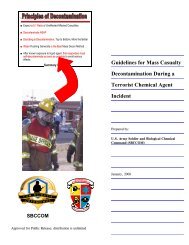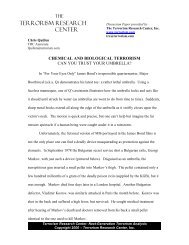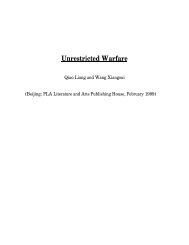Combating Proliferation of Weapons of Mass Destruction
Combating Proliferation of Weapons of Mass Destruction
Combating Proliferation of Weapons of Mass Destruction
Create successful ePaper yourself
Turn your PDF publications into a flip-book with our unique Google optimized e-Paper software.
economic, political, and diplomatic strengths to respond to proliferation when it occurs andtarget the weaknesses <strong>of</strong> specific proliferators. A policy that focuses on prevention isunlikely to succeed.Today, however, both diplomatic and military efforts to combat proliferation too narrowlyconfine the range <strong>of</strong> tools they employ and the goals they seek. In the case <strong>of</strong> DefenseDepartment-led efforts, there is a natural focus on military instruments to respond to thepotential threats <strong>of</strong> weapons <strong>of</strong> mass destruction. State Department-led efforts, bycontrast, naturally focus on formal diplomatic tools, such as treaties, agreements, andunderstandings, that seek pledges <strong>of</strong> compliance with international norms or theexpansion <strong>of</strong> multilateral agreements to limit the transfer <strong>of</strong> technology and materialsrelated to weapons <strong>of</strong> mass destruction.A set <strong>of</strong> effective strategies reflecting today’s proliferation challenges must go much furtherthan this. Strategies are needed to actively orchestrate the entire spectrum <strong>of</strong> U.S. andallied strengths in trade, finance, military force, intelligence, technology, and diplomaticleverage against proliferators’ clear vulnerabilities in one or more <strong>of</strong> these areas. Usingintelligence to identify and analyze these vulnerabilities would help focus interagencyoperations to achieve a more comprehensive set <strong>of</strong> objectives. These would include: (1)effectively dissuading nations from proliferating by targeting and influencing interestgroups or power centers within these nations to recognize the costs <strong>of</strong> such behavior, (2)encouraging the most hostile proliferating regimes towards internal political changes thatwould either reduce their proliferation activities or lead to new regimes that might give themup; (3) keeping our friends secure enough to defend themselves with our help againstproliferating neighbors so they do not resort to acquiring such weapons themselves, and(4) strengthening the global consensus for proliferation-related norms. These operationsand the specific strategies which they support, moreover, must be updated regularly toanticipate changes in proliferating countries and calibrate instruments accordingly.What we worry about most:• Terrorist acquisition or use <strong>of</strong> nuclear, chemical, or biological weapons• Possession <strong>of</strong>, and the manufacturing capability for, nuclear, chemical, or biological weapons by Iran,Iraq, North Korea, or other unfriendly states• Diversion <strong>of</strong> WMD-related weapons, technology, materials, and expertise from Russia• China’s role as a significant proliferator <strong>of</strong> ballistic missiles, weapons <strong>of</strong> mass destruction, andenabling technologies:• Destabilizing consequences <strong>of</strong> WMD programs in the Middle East, South Asia, and East Asia<strong>Combating</strong> these threats—and preventing the potential crises described above—requires agovernment that is organized to develop and carry out a coherent, coordinated, and sustainedresponse, using all available tools and an appropriate level <strong>of</strong> resources.4







